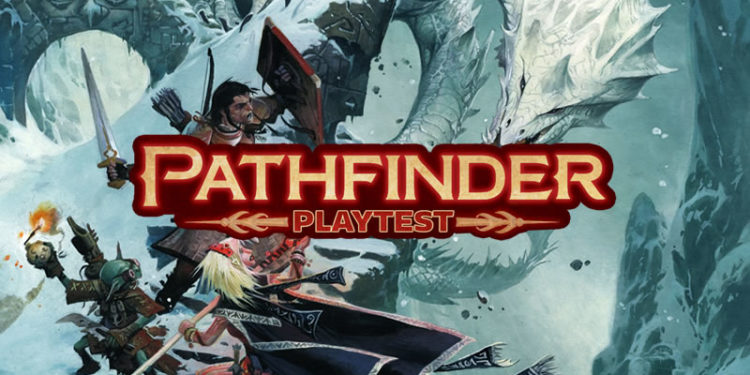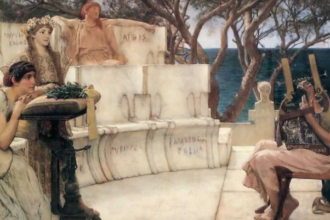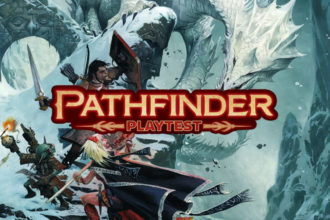Pathfinder Second Edition Playtest Breakdown, Part Three

Welcome back to the next section of my deep dive into the Pathfinder playtest rules. This time, we’re tackling the bard and cleric classes and, if time is on our side, the druid as well. No promises – oaths are for the paladin class, and that’s still some time away.
Part One | Part Two | Part Three
Bards
Now, bards were the first class I covered in my History of the Classes column for Tribality. Way back in those mist-shrouded days of… not quite four years ago, each class series was not yet what it would become in later days. That is to say, I only covered products that bore the imprimatur of Dungeons and Dragons – no Pathfinder, no Dungeon World, none of it. I therefore don’t have an article ready at hand with a design breakdown of the PF1 bard. The essential question of that series, what the hell is a bard?, comes to the fore in PF2’s offering.
- 8 hit points + Con modifier.
- Expert in Perception.
- Trained in Fortitude and Reflex, Expert in Will. It’s hypothetically interesting to see which classes are more or less resistant in each defense, but since the difference between trained and expert is just 1 point, your ability score modifiers are a much bigger deal than your class’s “good” or “bad” saves.
- 7 + Int modifier trained skills.
- Trained in all simple weapons plus a classic “bard weapons” list, so that you can be a swashbuckler. Trained in light armor and shields, for the same reason.
- Trained in occult spellcasting.
- There are four significant flavors of spellcasting in PF2, and Occult is one of them. The others are Arcane, Divine, and Primal. There’s… a lot more to the story than that, but I get ahead of myself.
- Crafting, Deception, Diplomacy, Intimidation, Occultism, Performance, and Society are their Signature Skills.
- Occult Spellcasting from 1st Much as 5e did, PF2 makes bards full-progression spellcasters rather than the 6th-level cap of 3.x and PF1. They can play an instrument in place of their Verbal, Somatic, and Material casting components. They know one 1st-level spell and four cantrips to start, and gain new spells known in a 2/1/2/1 pattern – 2 when they gain a new spell level, 1 when they do not. You add one more 1st-level spell to your repertoire from a later feature to fix this math.
- Okay, you know how 5e lets you cast spells using higher-level slots for increased effect? You can do that in PF2, but it’s a lot more complicated than simply you can do this. Once you reach 3rd level, the Spontaneous Heightening feature lets you pick two of your spells that you can freely cast with higher-level slots, and you can change these as part of your daily spell prep. Uh, not that you prepare spells; they just call it that to signify that it’s the time of day that you make your choices and refresh your spell energy. For spells you don’t choose for Spontaneous Heightening, you can only upcast them if you added them to your repertoire at that higher level.
- First Compositions is a real weird feature to try to explain, but I need to try because a lot of classes have a comparable feature. Okay, so you have a whole different kind of spellcasting also. It uses Spell Points rather than spell slots. I mean, the game calls them both spells and powers (including making some of them cantrips), but it’s just that a spell is a useful format for presenting a single action worth of content.
- Does this sound familiar? Every action is a spell, sort of? Yeah, that’s right, Paizo’s taking another major cue from 4e. Funny old world.
- Anyway, you know how a lot of classes in 3.x, PF1, and 5e have a sort of weird secondary/tertiary currency pool of uses per day? Well, PF2 files all of that under Powers and fuels them with Spell Points. Just to screw with us, though, you’ve got to look each cantrip and power you get from this feature up in the Spells chapter… but Powers don’t get their own master list in the book. Suffice it to say that this is structurally okay, but the information presentation is a disaster.
- Muses are not-so-secretly a choice of subclass. The bard chooses from Lore, Maestro, or Polymath, and this choice grants one extra 1st-level spell known and determines their 1st-level bard feat. But wait! Because of how the prereqs work, it also determines your 2nd-level bard feat, unless you want to spend your 2nd-level feat slot buying one of the 1st-level feats you didn’t get.
- Lore develops to be about both the Lore skill and Will defense.
- Maestro emphasizes buffing the party with composition cantrips and powers.
- Polymath emphasizes skill use of various kinds and a more wizard-like approach to spellcasting, incorporating a book and letting you add spells to it. Because of the latter, I’m inclined to see it as the most exciting, though it’s harder to judge its power.
- We all know about PF and its feat fetish, right? Not that I’m here to kinkshame.
- Your spellcasting increases to Expert at 12th level, Master at 16th, and Legendary at 19th. The main effect of this is that your spell DCs go up by 1 at each of those levels. There are probably some feats you qualify for as well.
The core of the bard is a primary spellcaster with a spell list on the creepy side. There’s a ton of traditional bard spells in the occult list, but there are also a lot of effects we’d call warlock-like (except that there’s no warlock in PF, just a few different flavors of sorcerer). There are a lot of different approaches available, particularly when we get into skill feats, but it looks like you’re mostly hanging back, casting spells, and buffing your allies with Spell Points. The central concepts they want to play with are the iron-willed sage, the broad-spectrum support character, and the highly improvisational skill monkey. I think I can buy into those concepts as traditional elements of the bard, sure.
The strange part is that a lot of “traditional” bard features are feats, as with Bardic Lore. Now, those feats are siloed – you’re only spending them on bard stuff. The outcome here is halfway between a subclass model (because they’re feat chains) and a playbook model (where almost all of your class features are a la carte). Most of the feats have meaningful theme, rather than being mechanics for mechanics’ sake; Cantrip Expansion and Additional Heightening are the offenders here.
Clerics
This is the most complicated class so far, just because you make two big choices at 1st level, one from a list of 21 and the other from a list of 37. It’s overwhelming, even though the information is more or less contained on just two pages, not counting the enormous number of spell and power descriptions that you need to cross-reference with the Spells chapter.
- 8 + Con modifier hit points. Where would we be without tradition?
- Trained in Perception.
- Expert in Fortitude and Will, Trained in Reflex.
- Trained in 5 + Int modifier skills. That’s a huge number of skill proficiencies for clerics, compared to other D&D/PF iterations.
- Trained in simple weapons, your deity’s favored weapon, light armor, medium armor, and shields.
- Trained in Divine spells.
- Diplomacy, Medicine, Performance, Religion, and one skill from your deity.
- Divine Spellcasting. Holding a holy symbol in one hand suffices for Somatic and Material components. By default, clerics have access to all common divine spells for spell preparation. Keep in mind that spell preparation involves specifying each spell slot at the start of the day – none of that loosey-goosey separation between spell prep slots and spellcasting slots like we’ve come to love in 5e. Clerics also have to prepare spells in their heightened form in order to cast them that way. I hope that the PF playtest feedback tells them that this heightening and prepping-each-slot-specifically system is just a lot of extra labor for reduced effectiveness.
- Deity and Domain are, as I suggested above, your two big choices. Your choice of deity constrains you to one of four domains, and it provides:
- Your flavor of energy channeling (positive, negative, or choose-at-character-creation)
- A trained skill
- A favored weapon – you might already get training with it from just the list of simple weapons, but if so, there’s a feat to juice it up for you
- Additional spells on your spell list – 3 for most deities, but ranging as high as 10 for Nethys.
- Your choice of Domain gives you a pool of Spell Points (equal to your Wisdom modifier) and one domain power that costs Spell Points to use. Each domain has an advanced power that you can gain with a feat. You can also buy up the rest of your deity’s domains with feats.
- Anathema is all the stuff your deity hates. The description of each deity’s anathematized actions are described in a different chapter. You lose some or most of your significant class features if you commit too many anathematized actions, and potentially regain them with an atone spell being cast for you.
- I’m glad to see Anathema as a class feature for several classes. Over in 5e, there are a bunch of classes that, as written, probably should lose the features they receive from their gods, oaths, patrons, or whatever if they do the wrong thing. Only the paladin really represents that, and it’s left wide open as to exactly how that happens. I respect the decision not to write a bunch of draconian rules around cutting off all gameplay at the first infraction, as so many years of paladin class writeups did, but I think ignoring or rejecting the question outright is a missed opportunity for those classes’ stories to mean
- Where 4e and 5e hard-marched away from alignment having any mechanical impact at all, PF made alignment mechanics the hill they’d die on: spells can be Good- or Evil-aligned, casting the wrong kind is anathematized, and there’s an Align Armament cleric feat that makes damn sure that being Neutral is the power-gaming option.
- Channel Energy lets the cleric cast either heal (if they channel positive energy) or harm (if negative), 3 + Cha mod times per day. Oh, good, additional attribute dependency. Spells cast this way are automatically heightened to the highest-level slot you can cast, and don’t cost any spell preparation as such. Keep in mind that in PF, healing hurts undead and harming heals undead. I like this feature reasonably well, in that I liked the aesthetic of Discipline, Holy, and Shadow priests back when I played WoW.
- As with bards and every other flavor of primary spellcaster, you gain Expert Spellcaster at 12th, Master Spellcaster a 16th, and Legendary Spellcaster at 19th.
Notice how little is actually here in the core of the cleric. There’s spellcasting, secondary spellcasting in the form of powers, and tertiary spellcasting in the form of Channel Energy. Everything else is a la carte, and one of the main things that a la carte selection does is that it makes sure you have no ribbon features, because you wouldn’t waste a feat on them. Don’t get me wrong, “everything is a feat” is a lot more cogent than the dizzying array of trade-in options and alternate features of PF1. This approach just requires so much system mastery to feel at all confident that you’re making good choices that it’s prohibitive to new players.
The feats on offer aren’t as thematically strong as the bard’s – there are a lot more that don’t tell me anything about the cleric that chooses them. Life Sapping is great, Turn Undead is great, but Conical Channel… I get why this is mechanically advantageous, but it carries no theme at all. Tacking on a bunch of little improvements to channeling seems tedious. Holy Castigation gets an honorable mention – expanding the “targets harmed by heal” list to include fiends tells its story quite clearly.
Oh, huh. There’s a cleric feat to gain a 10th-level spell slot, but there isn’t a bard feat to do the same. I guess bards are just a teensy bit less of primary spellcasters than clerics, druids, sorcerers, and wizards. No 10th-level Occult spells for you!
Druids
It’s only natural that druids are Primal spellcasters, with potential to go in a bunch of different directions based on your Druidic Order (pick one of the four) and your feat choices. There are a solid variety of playstyles within the druid, and their differences are more obvious on first read than in the other classes I’ve covered so far. The parallels to the very different 5e druid Circles explain themselves. Let’s call it leaning into the class’s long-term identity questions.
- 8 + Con modifier hit points, of course.
- Trained in Perception.
- Expert in Fort and Will, Trained in Reflex.
- 4 + Int modifier skills. Normal-ish for a druid.
- Trained in all simple weapons, the scimitar, non-metal light and medium armor, and non-metal light and heavy shields.
- Trained in Primal spells.
- Their Signature Skills are Crafting Nature, Survival, and one that comes from their Druidic Order (Athletics, Diplomacy, Acrobatics, or Intimidation).
- Primal Spellcasting lets you prepare spells from the full common Primal list, and use holly or mistletoe as your Somatic and Material components. You heighten spells the same way I described for the cleric.
- Druids also have Anathema conditions to worry about: some from the druid class itself, another from their Order. The popular blight and rot druid themes found in other D&D don’t precisely conflict with the core anathematized actions, but they’re at least close enough that PF2 might give them a pass.
- The Druidic Orders all rely on Spell Points, as we’ve seen before. Starting pool based on your Wisdom modifier.
- Animal grants an animal companion, Athletics, and heal animal as a power. (Funny story, I wrote heal beast as a spell for 5e rangers and druids some time back.)
- Leaf grants a Leshy Familiar, which like any other familiar improves its master’s spellcasting. It also grants Diplomacy and the goodberry In combination with its feat chain, it translates to 5e’s Circle of the Land.
- Storm grants the Storm Born feat, Acrobatics, and the tempest surge Blaster druid? Sure, works for me.
- Wild grants wild shaping, Intimidation, and the wild claws Wild Shaping, as a playstyle, is here to eat up all of your feats. It doesn’t become a combat playstyle until 4th level.
- Druidic Language, which you’re forbidden from sharing with your party members. This is one of those ribbon features that goes way, way back in D&D, but I just don’t see it carry a lot of story potential. I’m all about seeing GMs spend more time and energy telling stories that do make this interesting, though.
- Wild Empathy lets you talk to animals as if they were people, when it comes to making an impression or requesting something.
- Expert/Master/Legendary spellcaster, 12/16/19.
You can pick up the feats granted by the Druidic Orders with your later feats, but each of them has an additional Special feature that you only meet if you belong to the appropriate Order. That additional feature determines whether the feats are sort of trivial or anchors to your whole gameplay. That approaches continues intermittently in higher-level feats as well. As you advance, Animal and Wild are deeply demanding on your feat choices, while Leaf and Storm are reasonably flexible.
These feats are back toward being strong on theme. You’ve got to buy a lot of the traditional mid-to-high-level druid features if you care about them, like Thousand Faces and Woodland Stride. Overall, though, I’d say that the druid has a good variety of compelling ideas. Also, because of all the problems I have with 5e’s take on Wild Shaping, this is one thing I think PF2e handles more sanely. Also, treating animal companions as a chassis with minor creature-type modifications is a much better model than the awkwardness of 5e’s presentation.
Next time, we’ll move from a trio of casters to a trio of warrior-types: fighter, monk, and paladin.



